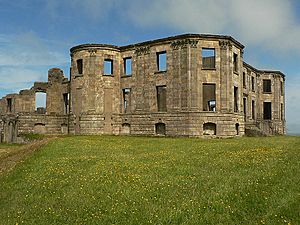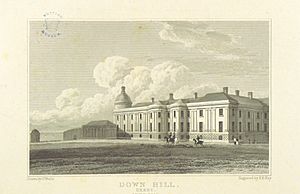Downhill House facts for kids
Downhill House was a large, grand house built in the late 1700s. It was made for Frederick, 4th Earl of Bristol, who was also the Bishop of Derry. People often called him 'the Earl-Bishop'. This impressive home was located in Downhill, County Londonderry, in what is now Northern Ireland.
Sadly, a big fire in 1851 destroyed much of the house. It was rebuilt in the 1870s, but after World War II, it slowly fell into disrepair. Today, Downhill House is a ruin, but it's part of a beautiful area managed by The National Trust. This area is known as Downhill Demesne and Mussenden Temple.
Contents
The Story of Downhill House
Who Built Downhill House?
The story of Downhill House began in the early 1770s. Frederick Hervey became the Bishop of Derry in 1768. He decided to build a magnificent estate at Downhill Demesne, near the village of Castlerock. The house was designed by an architect named Michael Shanahan. Some people think other famous architects, like James Wyatt or Charles Cameron, might have helped with the early plans too.
Building Downhill House and the nearby Mussenden Temple was very expensive, costing around £80,000. Imagine how much that would be today!
How Did People Enter the Estate?
The main entrance to the estate was first called the Lion's Gate. It had two statues of snow leopards, which were part of the Hervey family's family symbol. In 1784, a new entrance, the Bishop's Gate, replaced it. Inside the house, there were beautiful frescoes (paintings on walls), statues, and many artworks by famous artists.
What Happened After the Earl-Bishop Died?
When Lord Bristol (the Earl-Bishop) passed away in 1803, the estate went to his cousin, The Rev. Henry Bruce. Henry Bruce had helped manage the estate when the Earl-Bishop was away. Henry's sister was Frideswide Mussenden, and the famous Mussenden Temple was built for her. After she died, the temple became a memorial to her.
The Great Fire of 1851
Downhill House survived a huge storm in 1839 called the "Night of the Big Wind." However, in 1851, a terrible fire caused a lot of damage to the house. The library, which held many valuable books, was completely destroyed.
The Earl-Bishop had collected a huge amount of art, keeping it at Downhill and another house he owned. The fire destroyed works by famous artists like Correggio, Dürer, Murillo, Rubens, and Tintoretto. Luckily, many of the paintings were saved from the flames.
Rebuilding and Later Years
Restoration work on the house began in 1870 and finished in 1874. John Lanyon, the son of another architect, oversaw the rebuilding. He kept many of the original features, but some parts of the house's layout and decoration were changed or added.
During World War II, Downhill House was used to house RAF servicemen and women. The Bruce family owned the house until 1946. By 1950, the house was taken apart, and the land around it was sold. In 1980, The National Trust bought the house. The Mussenden Temple had already become a Trust property in the 1940s.
What Did People Think of the House?
While many people thought the house's location and design were "spectacular," not everyone agreed. After visiting in 1801, one person wrote that it was a shame so much money was spent on a place where the sea spray would damage the beautiful building. They thought it would become a "sad monument of human folly." Another visitor in 1812 said he had "Never seen so bad a house occupy as much ground."
Exploring the Demesne
The Downhill estate, or "Demesne," has more than just the house ruins. You can also find a dovecote (a building for doves), walled gardens, and a belvedere (a small building with a nice view), which was built for the Earl-Bishop's daughter. There's also a mausoleum (a grand tomb) dedicated to his brother, George, 3rd Earl of Bristol.
Finding Out More
If you're interested in learning more about Downhill House and the Hervey-Bruce family, there are over 1,000 documents at the Public Record Office of Northern Ireland (P.R.O.N.I.). These records date from the mid-1700s to the early 1900s and have lots of detailed information about Downhill.



